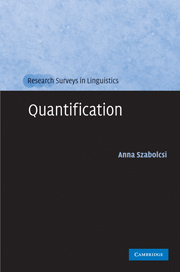Book contents
- Frontmatter
- Contents
- List of figures
- List of tables
- Acknowledgements
- 1 What this book is about and how to use it
- 2 Generalized quantifiers and their elements: operators and their scopes
- 3 Generalized quantifiers in non-nominal domains
- 4 Some empirically significant properties of quantifiers and determiners
- 5 Potential challenges for generalized quantifiers
- 6 Scope is not uniform and not a primitive
- 7 Existential scope versus distributive scope
- 8 Distributivity and scope
- 9 Bare numeral indefinites
- 10 Modified numerals
- 11 Clause-internal scopal diversity
- 12 Towards a compositional semantics of quantifier words
- Notes
- Bibliography
- Index
12 - Towards a compositional semantics of quantifier words
Published online by Cambridge University Press: 05 June 2012
- Frontmatter
- Contents
- List of figures
- List of tables
- Acknowledgements
- 1 What this book is about and how to use it
- 2 Generalized quantifiers and their elements: operators and their scopes
- 3 Generalized quantifiers in non-nominal domains
- 4 Some empirically significant properties of quantifiers and determiners
- 5 Potential challenges for generalized quantifiers
- 6 Scope is not uniform and not a primitive
- 7 Existential scope versus distributive scope
- 8 Distributivity and scope
- 9 Bare numeral indefinites
- 10 Modified numerals
- 11 Clause-internal scopal diversity
- 12 Towards a compositional semantics of quantifier words
- Notes
- Bibliography
- Index
Summary
In the past decade different lines of research have been converging on the claim that there is no sharp demarcation line in grammar corresponding to word boundaries. One such line is Distributed Morphology, which argues for “syntactic hierarchical structure all the way down” (see Halle and Marantz 1994, and a more recent overview in Harley and Noyer 2003). Another line leading to similar results was initiated in Kayne (2000, 2005a). This expansive view of syntax also converges with recent work at the syntax/semantics interface that has been busy dissecting items that traditional generalized quantifier theory took to be unanalyzed primitives; much of the second half of this book has surveyed such work. The closely related literature on polarity items and free-choice items, not reviewed here, is another rich source of decompositional analyses. Higginbotham (1991) is one of the early examples, with an analysis of whether as the wh-counterpart of either.
It seems useful to formulate the general thrust of this work, even though it is very programmatic at the moment:
(1) Compositional analysis cannot stop at the word level.
This contrasts with the more traditional strategy, which does not shy away from postulating fairly complex semantics for lexical items, but does not systematically strive to link their ingredients to morpho-syntactic components of the lexical items or to account for all the morphemes in evidence. A striking example is the determiner most, because its being the superlative of many and more is uncontroversial.
Information
- Type
- Chapter
- Information
- Quantification , pp. 189 - 205Publisher: Cambridge University PressPrint publication year: 2010
